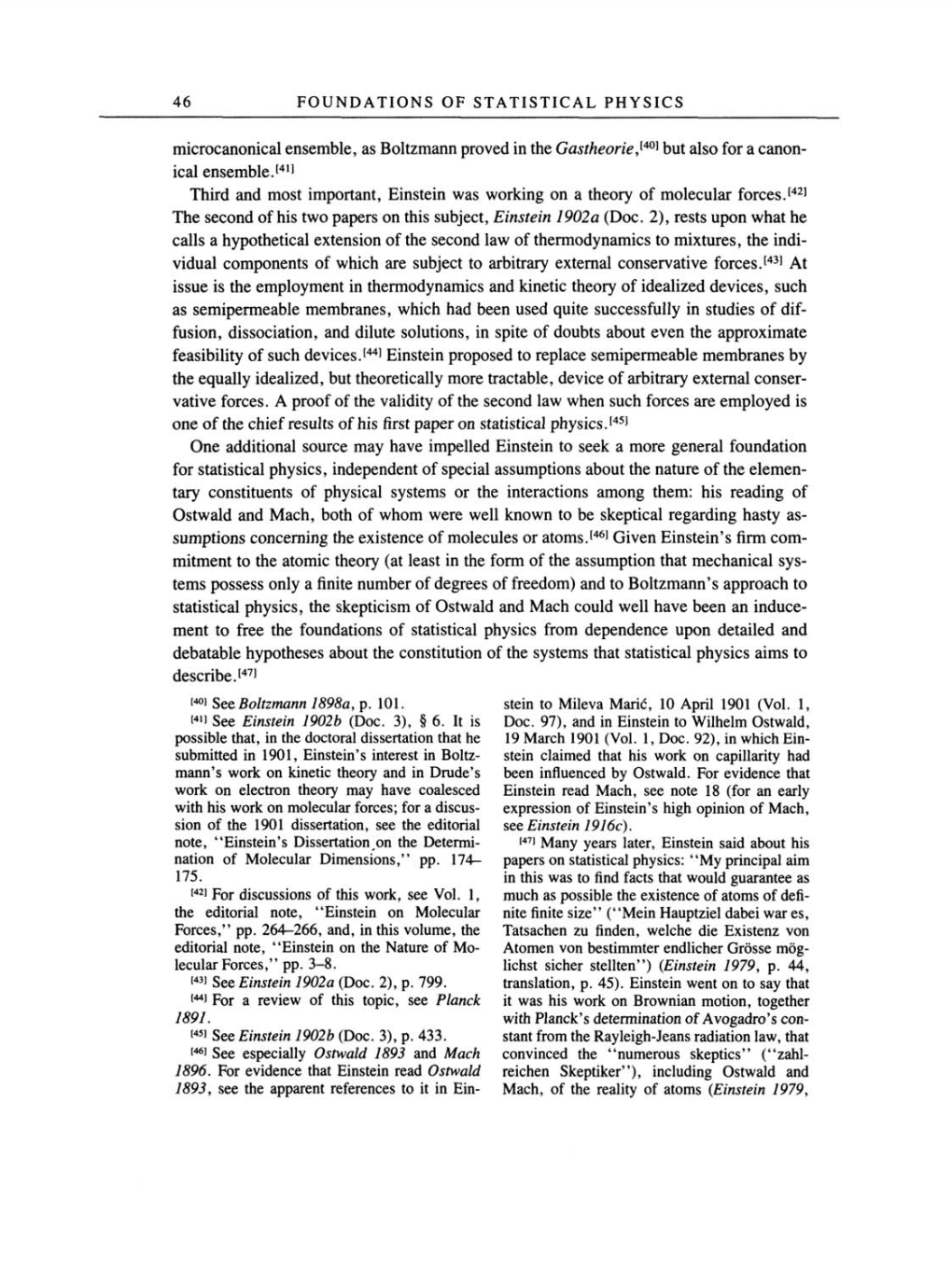46 FOUNDATIONS OF
STATISTICAL PHYSICS
microcanonical
ensemble,
as
Boltzmann
proved
in the
Gastheorie,[40]
but also
for
a canon-
ical ensemble.[41]
Third and most
important,
Einstein
was working on a theory
of molecular
forces.[42]
The second
of
his two
papers on
this
subject,
Einstein 1902a
(Doc. 2),
rests
upon
what he
calls
a hypothetical
extension
of
the second law
of
thermodynamics
to
mixtures,
the indi-
vidual
components
of
which
are subject
to
arbitrary
external conservative
forces.[43]
At
issue
is
the
employment
in
thermodynamics
and kinetic
theory
of
idealized devices, such
as semipermeable
membranes,
which had been used
quite successfully
in
studies
of
dif-
fusion, dissociation,
and dilute
solutions,
in
spite
of
doubts about
even
the
approximate
feasibility
of
such
devices.[44]
Einstein
proposed
to
replace semipermeable
membranes
by
the
equally
idealized,
but
theoretically more
tractable,
device
of
arbitrary
external
conser-
vative forces.
A proof
of
the
validity
of
the second law when such forces
are
employed is
one
of
the
chief
results
of
his first
paper
on
statistical
physics.[45]
One additional
source may
have
impelled
Einstein to seek
a more general
foundation
for statistical
physics, independent
of
special assumptions
about the nature
of
the elemen-
tary
constituents
of
physical systems or
the interactions
among
them: his
reading
of
Ostwald and
Mach,
both
of
whom
were
well
known to
be
skeptical regarding hasty as-
sumptions concerning
the existence
of
molecules
or atoms.[46]
Given
Einstein's
firm
com-
mitment to the atomic
theory
(at
least in
the
form
of
the
assumption
that
mechanical
sys-
tems
possess only a
finite number
of
degrees
of
freedom)
and to
Boltzmann's
approach
to
statistical
physics,
the
skepticism
of
Ostwald and Mach could well have been
an
induce-
ment to free the foundations
of
statistical
physics
from
dependence upon
detailed and
debatable
hypotheses
about the constitution
of
the
systems
that
statistical
physics
aims to
describe.[47]
[40]
See Boltzmann
1898a,
p.
101.
[41]
See Einstein 1902b
(Doc. 3),
§
6. It
is
possible that,
in the doctoral dissertation that he
submitted in
1901,
Einstein's
interest in Boltz-
mann's
work
on
kinetic
theory
and in
Drude's
work
on
electron
theory may
have coalesced
with his work
on
molecular
forces;
for
a
discus-
sion
of
the
1901 dissertation,
see
the editorial
note,
"Einstein's
Dissertation
on
the Determi-
nation
of
Molecular
Dimensions,"
pp.
174-
175.
[42]
For discussions
of
this
work, see
Vol.
1,
the
editorial
note,
"Einstein
on
Molecular
Forces,"
pp.
264-266,
and,
in this volume, the
editorial
note,
"Einstein
on
the Nature
of
Mo-
lecular Forces,"
pp.
3-8.
[43]
See Einstein 1902a
(Doc. 2), p.
799.
[44]
For
a
review
of
this
topic, see
Planck
1891.
[45]
See Einstein 1902b
(Doc. 3),
p.
433.
[46]
See
especially
Ostwald
1893
and
Mach
1896. For evidence
that
Einstein read Ostwald
1893,
see
the
apparent
references to
it in
Ein-
stein
to
Mileva
Maric,
10
April 1901 (Vol.
1,
Doc.
97),
and in Einstein to
Wilhelm
Ostwald,
19
March
1901 (Vol.
1,
Doc.
92),
in which Ein-
stein claimed that his work
on capillarity
had
been
influenced
by
Ostwald. For evidence that
Einstein read
Mach, see
note
18 (for
an
early
expression
of Einstein's
high opinion
of
Mach,
see
Einstein
1916c).
[47]
Many years
later,
Einstein said about his
papers on
statistical
physics:
"My
principal
aim
in this
was
to
find facts that would
guarantee as
much
as possible
the existence
of
atoms
of
defi-
nite finite
size"
("Mein
Hauptziel
dabei
war
es,
Tatsachen
zu finden,
welche die Existenz
von
Atomen
von
bestimmter endlicher Grösse
mög-
lichst sicher stellten")
(Einstein 1979,
p.
44,
translation,
p.
45).
Einstein went
on
to
say
that
it
was
his work
on
Brownian
motion,
together
with
Planck's
determination
of
Avogadro's
con-
stant from the
Rayleigh-Jeans
radiation
law,
that
convinced the
"numerous
skeptics"
("zahl-
reichen
Skeptiker"),
including
Ostwald and
Mach,
of
the
reality
of
atoms
(Einstein 1979,
